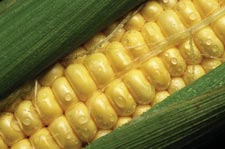High fructose corn syrup: why are we eating it?
by Samia McCully, N.D.
This article was originally published in March 2006

(March 2006) — Walk down the aisles of most grocery stores and you’ll be sure to find a common ingredient: high fructose corn syrup (HFCS). That is, except at PCC.
PCC delis began eliminating products with HFCS four years ago and have been 100 percent HFCS-free for some time. PCC’s grocery department stopped taking new products with HFCS two years ago and is in the process of identifying and phasing out the few remaining items that still contain it.
Elsewhere since the 1970s, HFCS has become an increasingly pervasive part of the American diet. It has replaced much of the sugar in soft drinks, breads, crackers, cookies, jams, condiments and energy bars. The simple reason is that it’s cheaper and sweeter than sugar.
Fructose, a natural component of whole foods, is chemically isolated to be present in much larger amounts in HFCS. It was estimated in 1997 that Americans consumed an average of 63 pounds of HFCS each year.
It’s well known among scientists that fructose is metabolized differently than whole, natural sugars. Fructose stimulates significantly less insulin and, as a result, our brains do not register the same feelings of fullness.
It is thought that this mechanism may be at least partly responsible for the ever-growing obesity epidemic in America. The metabolism of fructose also can lead to increased triglycerides, a risk factor for heart disease.
A 2005 article in the Alternative Medical Review found many potential damaging effects of high fructose consumption. Some of these effects include insulin resistance, diabetes mellitus, non-alcoholic fatty liver disease and irritable bowel syndrome.
The Journal of Nutrition published an article in 1998 suggesting that long-term consumption of fructose advances the aging process and contributes to the complications of diabetes.
Why, then, are we still eating it? Probably because it’s difficult to avoid and most consumers aren’t aware of the long-term consequences.
Healthier alternatives exist. Among them are evaporated cane juice, molasses, honey, maple syrup and stevia, all natural sweeteners that you’ll find at PCC. But manufacturers change ingredients without notice, so PCC always encourages shoppers to read labels.
